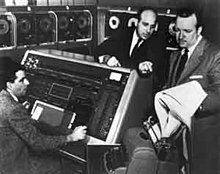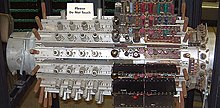UNIVAC I
The UNIVAC I ( UNIV ersal A utomatic C omputer I) was the first commercial computer made in the USA . It was developed by John Presper Eckert and John William Mauchly of the Eckert-Mauchly Computer Corporation and built by the computer company Remington Rand .


The first UNIVAC was delivered to the United States Census Bureau on May 30, 1951 and commissioned on June 14. On February 1, 1952, the US Air Force received a UNIVAC I. The fifth was given to CBS in 1952 to predict the results of the presidential election. With a sample size of only seven percent, he calculated the correct result: Eisenhower will win with a large majority.
The UNIVAC I consisted of 5,200 tubes , 18,000 crystal diodes and weighed up to 13 tons, required an electrical output of up to 125 kilowatts and could perform 1905 arithmetic operations per second. The run-time memory of mercury included 4.3 m x 2.4 m x 2.6 m. The access time was 40 to 404 µs. The entire system required a floor space of 35.5 square meters .
They used delay lines for dynamic data storage. They consisted of a mercury tube with an oscillating quartz attached to both ends . If the quartz was stimulated to oscillate by a short current surge, the ultrasonic waves generated in the mercury were propagated at a speed of two kilometers per second. After a corresponding delay time, the rise in pressure of the waves on the other quartz crystal generated an increase in voltage. If the transmitting quartz was refreshed with corresponding current surges synchronously with the clock of the arithmetic unit (analogous to the DRAM ), a serial bit pattern of a certain length could circulate in the mercury as long as desired. In this way, it is stored in the mercury using sound waves .
The main memory held 1000 words with twelve decimal places (including one place for the sign ). The command list comprised 45 different commands , two commands each encoded in one word .
The American Federal Bureau of Censuses received a second machine in October 1954. The starting price of $ 159,000 climbed to $ 1.5 million, making it too high for most universities. Only three machines were donated to US universities.
The first UNIVAC I in Germany was officially put into operation on October 19, 1956 by Carl Hammer, Director of the Battelle Institute in Frankfurt . The inauguration of Remington Rand's first European data center marks the start of commercial data processing and especially of IT training in Germany. It was operated in shifts by twelve to 20 people. Free computing capacities on the UNIVAC I were rented for 1,470 marks per hour (2014 approx. 3,500 euros).
A total of 46 UNIVAC-I machines were built and delivered.
